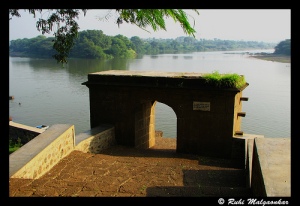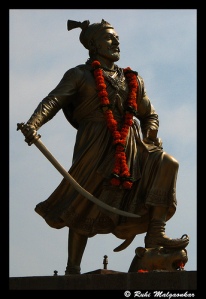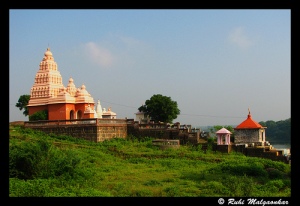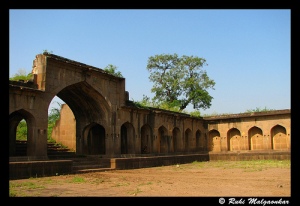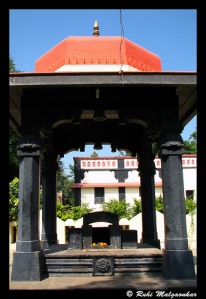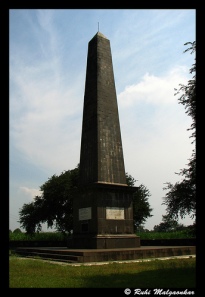This was my second visit to Panhalgad a.k.a Panhala. We reached Panhala in the afternoon and still the weather was pleasantly cool on the top. First visit was more of ‘khao-pio-maja karo’ types. I made it a point to hire a guide this time, who could explain and give the historical information about the fort.
To reach Panhalgad (from Kolhapur):
- Take Kolhapur-Ratnagiri highway (NH204)
- Travel some 20-25 Kms to reach the base of the fort.
- Take the road to the top.
- Car is allowed inside the fort and you can see different places on this fort by driving your own vehicle.
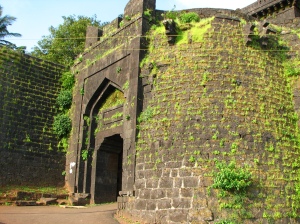 About Panhalgad (मराठी: पन्हाळा, पन्हाळगड), also known as ‘Panhala’or ‘Panhalla’ or ‘Panalla’ which literally means ‘home of the serpents’. The Shilahara king Bhoja II between 1178 and 1209 CE built Panhala fort. The Yadavas defeated Raja Bhoja and captured this fort and then through changing hands it came to Adilshah of Bijapur. In 1659, Shivaji Maharaj defeated Bijapur general Afzal Khan and conquered Panhalgad. In May 1660, Adil Shah II sent his uncle Siddi Johar to lay siege to Panhala. Siddi Johar came with huge army and the siege continued for 4 months. At the end of which all provisions in the fort were exhausted and Shivaji Maharj was on the verge of being captured. Also there was no enough force to fight against Johar and his army.
About Panhalgad (मराठी: पन्हाळा, पन्हाळगड), also known as ‘Panhala’or ‘Panhalla’ or ‘Panalla’ which literally means ‘home of the serpents’. The Shilahara king Bhoja II between 1178 and 1209 CE built Panhala fort. The Yadavas defeated Raja Bhoja and captured this fort and then through changing hands it came to Adilshah of Bijapur. In 1659, Shivaji Maharaj defeated Bijapur general Afzal Khan and conquered Panhalgad. In May 1660, Adil Shah II sent his uncle Siddi Johar to lay siege to Panhala. Siddi Johar came with huge army and the siege continued for 4 months. At the end of which all provisions in the fort were exhausted and Shivaji Maharj was on the verge of being captured. Also there was no enough force to fight against Johar and his army.
The only option left with Shivaji Maharaj was an escape from the fort. With few trusted soldiers and his commander Baji Prabhu Deshpande, they escaped in the dead of the night to fort Vishalgad on 13 July 1660. Another troop with Shivaji’s barber, Shiva Kashid, who resembled like Shivaji in his looks, kept the enemy engaged, giving them an impression that Shiva Kashid was actually Shivaji. Shiva Kashid was caught and killed immediately after the truth was known. Furious Siddi Johar sent his army to chase Shivaji.
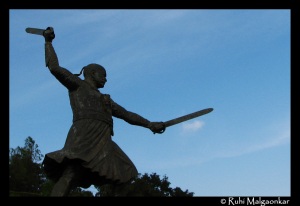 At the pass through the mountains, called ‘Ghod Khind’ (‘khind’ means ‘narrow pass in mountainous terrain’, ‘Ghod Khind’ means Horse Pass – literally through which only a single horse could pass) Baji Prabhu let Shivaji Maharaj proceed towards fort Vishalgad and fought a battle with 300 odd men against Siddi Johar’s army in thousands. He fought bravely till he heard the cannon firing from fort Vishalgad, which was signalling that Shivaji has reached safely. Baji Prabhu fought relentlessly, at times with swords in both hands. He breathed his last along with many great men of Shivaji like Sambhaji Jadhav, Bandals, etc.
At the pass through the mountains, called ‘Ghod Khind’ (‘khind’ means ‘narrow pass in mountainous terrain’, ‘Ghod Khind’ means Horse Pass – literally through which only a single horse could pass) Baji Prabhu let Shivaji Maharaj proceed towards fort Vishalgad and fought a battle with 300 odd men against Siddi Johar’s army in thousands. He fought bravely till he heard the cannon firing from fort Vishalgad, which was signalling that Shivaji has reached safely. Baji Prabhu fought relentlessly, at times with swords in both hands. He breathed his last along with many great men of Shivaji like Sambhaji Jadhav, Bandals, etc.
Ghod Khind was covered with blood of 300 Marathas who willingly gave up their lives and fought to the last man for the cause of freedom. The pass was then renamed as ‘Pavan Khind’ which means ‘Sacred Pass’ and known for sacrifice and bravery of Baji Prabhu Deshpande and his men in Maratha history.
The fort went to Adil Shah. Finally and permanently Shivaji occupied the fort in 1673. Panhala fort housed 15,000 horses and 20,000 soldiers in Shivaji’s rule.
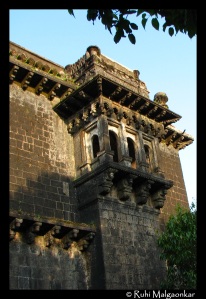 Much later, Sambhaji, Shivaji’s son was kept under house arrest in Panhala fort. He escaped from here along with his wife on 13 December 1678 and attacked Bhupalgad. He returned to Panhala, however, on 4 December 1679 to reconcile with his father, just before his father’s death on 4 April, 1680. The fort remained with Chatrapati Sambhaji Maharaj, Chatrapati Rajaram, Tarabai and Chatrapati Shahu until it went to British and now belongs to Government of India.
Much later, Sambhaji, Shivaji’s son was kept under house arrest in Panhala fort. He escaped from here along with his wife on 13 December 1678 and attacked Bhupalgad. He returned to Panhala, however, on 4 December 1679 to reconcile with his father, just before his father’s death on 4 April, 1680. The fort remained with Chatrapati Sambhaji Maharaj, Chatrapati Rajaram, Tarabai and Chatrapati Shahu until it went to British and now belongs to Government of India.
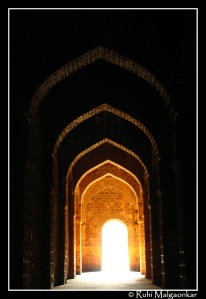 Awesome statue of Baji Prabhu Deshpande is erected at the entrance of the fort. Our guide took us to different places of interest like – Tabak udyan, Andhar Baav (hidden well to protect drinking water from getting poisonated), Someshwar temple, Teen Darwaza, Raj Dindi bastion, Sajja Kothi (where Sambhaji was kept under house arrest), ancient Hanuman temple, Rani Tarabai’s palace, Ambabai temple, Kalavantin Sajja, Ambarkhana (Graineries and commodities storage), Dharmakothi (from where donations were done to poor and needful), Teen Darwaja, Wagh Darwaja, Someshwar temple, etc. The fort is one of the largest forts in Deccan with perimeter of 14 km, 100+ lookout posts, 2772 feet above sea level and 400m above the surroundings with more than 7 km of fortifications (Tatabandi). Views of Jyotiba, Konkan, Masai Pathar from the top of the fort are amazing.
Awesome statue of Baji Prabhu Deshpande is erected at the entrance of the fort. Our guide took us to different places of interest like – Tabak udyan, Andhar Baav (hidden well to protect drinking water from getting poisonated), Someshwar temple, Teen Darwaza, Raj Dindi bastion, Sajja Kothi (where Sambhaji was kept under house arrest), ancient Hanuman temple, Rani Tarabai’s palace, Ambabai temple, Kalavantin Sajja, Ambarkhana (Graineries and commodities storage), Dharmakothi (from where donations were done to poor and needful), Teen Darwaja, Wagh Darwaja, Someshwar temple, etc. The fort is one of the largest forts in Deccan with perimeter of 14 km, 100+ lookout posts, 2772 feet above sea level and 400m above the surroundings with more than 7 km of fortifications (Tatabandi). Views of Jyotiba, Konkan, Masai Pathar from the top of the fort are amazing.
The replica fort called ‘Pawangad’ lies adjacent to Panhalgad. It has ‘Tupachi Vihir’ (ghee well) i.e. a well built for specially for storing ghee. In olden times, a well was used to store and decompose ghee, which was later used as an antiseptic for injured soliders. Application of this ghee on wounds created intense burning sensation but avoided turning septic and healed faster. Apart from Pawangad only forts Ajinkyatara and Purandar have the remains of such wells and Ranjan (a large earthen water-jar).
Panhalgad and Pawangad forts together stand today depicting magnificent history of India. While descending, I again halted at statues of Baji Prabhu and Shiva Kashid for few moments. Panhalgad once again gave me a chance to experience and remember the history of great Shivaji Maharaj and his men who made Maharashtra.
